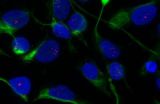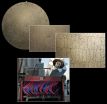(Press-News.org) Bioengineers at the University of California, San Diego have developed a method of modeling, simultaneously, an organism's metabolism and its underlying gene expression. In the emerging field of systems biology, scientists model cellular behavior in order to understand how processes such as metabolism and gene expression relate to one another and bring about certain characteristics in the larger organism.
In addition to serving as a platform for investigating fundamental biological questions, this technology enables far more detailed calculations of the total cost of synthesizing many different chemicals, including biofuels. Their method accounts, in molecular detail, for the material and energy required to keep a cell growing, the research team reported in the journal Nature Communications.
"This is a major advance in genome-scale analysis that accounts for the fundamental biological process of gene expression and notably expands the number of cellular phenotypes that we can compute," said Bernhard Palsson, Galetti Professor of Bioengineering, at the UC San Diego Jacobs School of Engineering.
"With this new method, it is now possible to perform computer simulations of systems-level molecular biology to formulate questions about fundamental life processes, the cellular impacts of genetic manipulation or to quantitatively analyze gene expression data," said Joshua Lerman, a Ph.D. candidate in Palsson's Systems Biology Research Group.
The team's method can be compared to understanding both the chemical reactions and the machinery that are required to refine crude oil into petrol in a large, industrial factory. Modeling metabolism tells you what biochemical reactions need to take place. Modeling the organism's gene expression tells you what kind of machinery you need. The team's method specifically accounts for the expression of enzymes, which are the molecular machines responsible for the biochemical processes of life. With this knowledge, it is possible to explore how an organism distributes its resources to promote growth and how genetic manipulation of these organisms alters this distribution.
"What you could hypothetically do with our model is simulate the total cost of producing a value-added product, such as a biofuel. That includes all the operating and maintenance costs," said Daniel Hyduke, a project scientist in Palsson's lab. Hyduke said the method has the potential to help streamline industrial metabolic engineering efforts by providing a near complete accounting of the minimal material and energy costs associated with novel strain designs for biofuel, commodity chemicals, and recombinant protein production.
Hyduke and Lerman prototyped the method on the minimal, yet metabolically versatile, hyperthermophile Thermotoga maritima. Because T. maritima is not currently ready for use in industrial applications, Hyduke and Lerman are working as part of a larger team to produce similar models for industrially relevant microorganisms, such as E. coli.
"We've built a virtual reality simulator of metabolism and gene expression for Thermotoga maritima, and shown that it much better approximates phenotypes of cells than modeling metabolism in isolation," said Lerman.
###This work was supported in part by the US National Institute of
Allergy and Infectious Diseases and the US Department of Health and
Human Services through interagency agreement Y1-AI-8401-01, DOE Awards
DE-FG02-09ER25917 and DE-FG02-08ER64686. Proteomic analyses were
performed in the Environmental Molecular Sciences Laboratory, a US DOE
BER national scientific user facility at Pacific Northwest National
Laboratory. D.R.H. is supported in part by a Seed Award from the San
Diego Center for Systems Biology funded by NIH/NIGMS (GM085764).
Molecular economics: New computer models calculate systems-wide costs of gene expression
2012-08-08
ELSE PRESS RELEASES FROM THIS DATE:
Marin County's high breast cancer rate may be tied to genetics
2012-08-08
Marin County, California has one of the highest rates of breast cancer in the world, a fact that scientists know has nothing to do with the land itself but with some other, unknown factor.
A new study that analyzed mouth buccal cell samples stored frozen at the University of California, San Francisco (UCSF) suggests what this factor may be: a genetic trait present among women within the county's predominantly white population.
In an article published online this week by the Journal of the American College of Surgeons, which will appear in the November 2012 print issue, ...
A molecule central to diabetes is uncovered
2012-08-08
At its most fundamental level, diabetes is a disease characterized by stress -- microscopic stress that causes inflammation and the loss of insulin production in the pancreas, and system-wide stress due to the loss of that blood-sugar-regulating hormone.
Now, researchers led by scientists at the University of California, San Francisco (UCSF) have uncovered a new key player in amplifying this stress in the earliest stages of diabetes: a molecule called thioredoxin-interacting protein (TXNIP). The molecule, they've discovered, is central to the inflammatory process that ...
Study sheds light on underlying causes of impaired brain function in muscular dystrophy
2012-08-08
The molecular missteps that disrupt brain function in the most common form of adult-onset muscular dystrophy have been revealed in a new study published by Cell Press. Myotonic dystrophy is marked by progressive muscle wasting and weakness, as well as excessive daytime sleepiness, memory problems, and mental retardation. A new mouse model reported in the August 9 issue of the journal Neuron reproduces key cognitive and behavioral symptoms of this disease and could be used to develop drug treatments, which are currently lacking.
"The new animal model reproduces important ...
The first public data release from BOSS, the Baryon Oscillation Spectroscopic Survey
2012-08-08
The Third Sloan Digital Sky Survey (SDSS-III) has issued Data Release 9 (DR9), the first public release of data from the Baryon Oscillation Spectroscopic Survey (BOSS). In this release BOSS, the largest of SDSS-III's four surveys, provides spectra for 535,995 newly observed galaxies, 102,100 quasars, and 116,474 stars, plus new information about objects in previous Sloan surveys (SDSS-I and II).
"This is just the first of three data releases from BOSS," says David Schlegel of the U.S. Department of Energy's Lawrence Berkeley National Laboratory (Berkeley Lab), an astrophysicist ...
EARTH: Shake, rattle and roll
2012-08-08
Alexandria, VA – A team of researchers may have discovered a way to hear earthquakes. Not the noises of rattling windows and crumbling buildings, but the real sounds an earthquake makes deep underground as rock grinds and fails catastrophically. Typical seismic waves have frequencies below the audible range for humans, but the August issue of EARTH shows you where to find the voice of one seismic monster: the March 11, 2011, magnitude-9.0 Tohoku earthquake in Japan.
Beyond the novelty of simply hearing an earthquake, the team found that the new technology could possibly ...
UK hotel industry alive with innovation
2012-08-08
Large hotel chains are quick to adopt and adapt innovations developed in other industries, while smaller hotels make almost continual incremental changes in response to customers' needs. The UK hotel industry is alive with innovation and new ways of improving service for customers, research funded by the Economic and Social Research Council (ESRC) has found.
The findings of a project led by Professor Gareth Shaw of Exeter University and Professor Allan Williams of Surrey University run counter to the traditional image of the hotel sector as slow to change. Official measures ...
Unusual weather events identified during the Black Saturday bushfires
2012-08-08
Research has revealed that the extremely hot, dry and windy conditions on Black Saturday combined with structures in the atmosphere called 'horizontal convective rolls' -similar to streamers of wind flowing through the air - which likely affected fire behaviour.
The study is the first of its kind to produce such detailed, high-resolution simulations of weather patterns on the day and provides insights for future fire management and warning systems.
The work was led by Dr Todd Lane and Ms Chermelle Engel from The University of Melbourne with Prof Michael Reeder (Monash ...
Benefit of PET and PET/CT in ovarian cancer is not proven
2012-08-08
Due to the lack of studies, there is currently no proof that patients with ovarian cancer can benefit from positron emission tomography (PET) alone or in combination with computed tomography (CT). As regards diagnostic accuracy, in certain cases, recurrences can be detected earlier and more accurately with PET or PET/CT than with conventional imaging techniques. This is the conclusion of the final report by the German Institute for Quality and Efficiency in Health Care (IQWiG) in Cologne that was published on 23 May 2012.
More reliable diagnosis is supposed to improve ...
Queen's University Belfast makes significant cancer breakthrough
2012-08-08
A major breakthrough by scientists at Queen's University Belfast could lead to more effective treatments for throat and cervical cancer.
The discovery could see the development of new therapies, which would target the non-cancerous cells surrounding a tumour, as well as treating the tumour itself.
Researchers at Queen's Centre for Cancer Research and Cell Biology have found that the non-cancerous tissue, or 'stroma', surrounding cancers of the throat and cervix, plays an important role in regulating the spread of cancer cells.
The discovery opens the door for the development ...
Scientists discover the truth behind Colbert's 'truthiness'
2012-08-08
Trusting research over their guts, scientists in New Zealand and Canada examined the phenomenon Stephen Colbert, comedian and news satirist, calls "truthiness"—the feeling that something is true. In four different experiments they discovered that people believe claims are true, regardless of whether they actually are true, when a decorative photograph appears alongside the claim. The work is published online in the Springer journal, Psychonomic Bulletin & Review.
"We wanted to examine how the kinds of photos people see every day—the ones that decorate newspaper or TV ...




